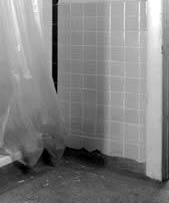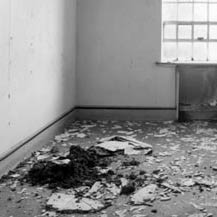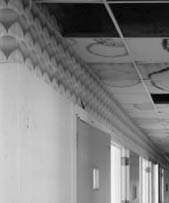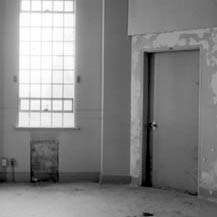 |
 |
| |
| |
| |
| |
| |
| |
| |
| |
| |
| |
| |


 This
exhibition by Michael de Courcy provides us with an opportunity to consider
the mosaic of stories that informs our viewing of place. His inquiry into
Woodlands, the area, its peoples and histories, is depicted through a
number of different media, such as photographs, screenprints and texts.
This multiple means of approach allows us to recognize the complexity
of the subject matter, and how certain values have been configured and
reconfigured throughout time. The combination of text and imagery also
provides us with insights into how lives have been shaped and the means
by which they have become known– through institutional history,
the public media, and personal testimony. The history of Woodlands is
multi-dimensional and through this exhibition, viewers can appreciate
its ambiguities and contradictions, and, above all, the many human qualities
that have fashioned its existence.
This
exhibition by Michael de Courcy provides us with an opportunity to consider
the mosaic of stories that informs our viewing of place. His inquiry into
Woodlands, the area, its peoples and histories, is depicted through a
number of different media, such as photographs, screenprints and texts.
This multiple means of approach allows us to recognize the complexity
of the subject matter, and how certain values have been configured and
reconfigured throughout time. The combination of text and imagery also
provides us with insights into how lives have been shaped and the means
by which they have become known– through institutional history,
the public media, and personal testimony. The history of Woodlands is
multi-dimensional and through this exhibition, viewers can appreciate
its ambiguities and contradictions, and, above all, the many human qualities
that have fashioned its existence.
My own experience of this project began with a personal tour of Woodlands given by the artist in the fall of 2002. The site, overlooking the Fraser River, is impressive. It has a distinctive “picturesque” quality with its majestic trees and wide lawns. This quality of the grounds was intriguing, as it conveyed a sense of peacefulness, perhaps even of retreat. In the past, this bucolic aspect of the land was simply a product of the fact that the institution was built outside the city of New Westminster, on a one hundred acre site on the north bank of the Fraser. Today, such placement, in addition to the presence of aged trees, makes the grounds a highly prized commodity. The pressure to transform such an area is great, given the present desire to both live among and preserve natural resources within the city. In a more general sense, the cultural investment in nature leads to its constant reconfiguration, a history contained in the Woodlands site. In a previous century, nature simply was there, something to be fashioned and changed into markers of civilization. Now it exists under certain designations, such as heritage trees, parks, greenways and gardens. The Woodlands acreage is to be rezoned to accommodate these more modern needs and desires especially as increases in both population and economic mobility direct how remaining lands within the city are to be used.
Yet, the tranquil quality of Woodlands’ park-like grounds is counterpointed by the existent buildings and their varying states of disrepair. As my tour was confined to the exterior of these structures, I could only note how the very “civilized” nature that I had previously observed on the grounds was in fact invading the buildings and slowly bringing about their demise. Tufts of grass and weed poked through pathways, public access areas were choked with tree growth. Both nature and buildings were in need of attention. Again, I was reminded of how such factors signify a variety of interests. A building is not simply a structure that stands in isolation; rather it stands for certain values and aspects of human experience. Its abandonment and demolition also speak to larger social issues. Moreover, as the buildings are part of a community, both they and other aspects of the site, such as its parks and roadways, can be thought of in terms of their relationship to one another, and the kinds of social and economic contexts in which they exist.
 Most
importantly, as I looked upon the silent buildings, I reflected on the
people who have lived in them and how their experiences must be acknowledged,
recorded and preserved. Woodlands is a reminder of how land and buildings
are archives of social and cultural meaning2 as they retain the histories
of peoples, their patterns of habitation, and their struggles for recognition
if they are a marginalized group. The cemetery on the Woodlands grounds
is one aspect of this idea. As one writer has noted, a cemetery, among
other things, is a field of remembrance forthe living.3 As such, to demolish
or radically alter it, as has happened at Woodlands, is to erase the significance
of the lives of those buried there, an act that not only affronts those
who lived in the past, but present and future generations as well. The
act of preserving, retaining, and marking the lives of people who have
come before us is a statement about our present values, and our hope that
what we hold dear will be retained in the future.
Most
importantly, as I looked upon the silent buildings, I reflected on the
people who have lived in them and how their experiences must be acknowledged,
recorded and preserved. Woodlands is a reminder of how land and buildings
are archives of social and cultural meaning2 as they retain the histories
of peoples, their patterns of habitation, and their struggles for recognition
if they are a marginalized group. The cemetery on the Woodlands grounds
is one aspect of this idea. As one writer has noted, a cemetery, among
other things, is a field of remembrance forthe living.3 As such, to demolish
or radically alter it, as has happened at Woodlands, is to erase the significance
of the lives of those buried there, an act that not only affronts those
who lived in the past, but present and future generations as well. The
act of preserving, retaining, and marking the lives of people who have
come before us is a statement about our present values, and our hope that
what we hold dear will be retained in the future.
Photographs of the interior of the building provide yet more insights into the significance of this site. On one level, the images depict tightly structured spaces; the relationships between the shapes, lines, and colours of various architectural elements allude to a controlled and self-contained world. Yet this very ideal is held in tension with the gradual deterioration of the buildings. In one photograph of a bedroom, parts of the ceiling have fallen in, with pieces of tile lying scattered about on the floor. Dayrooms appear dishevelled as the paint and wallpaper are peeling off walls. The photographs indicate that the rigid geometry of human structures, and their allusion to order and regulation, are slowly breaking down due to lack of attention.
 On
another level, the photographs of interior spaces are springboards for
our imagination. Looking at these images in conjunction with the portraits
of former residents, I try to envisage how these spaces were occupied,
and the kinds of activities that might have occurred there. The history
here runs to extremes; interactions with residents range from those that
have destroyed fundamental trusts, to ones emanating from genuine concern.
The photographs of the former residents are therefore important components
to the exhibition. Taken mostly from the “head on” viewpoint,
the images depict them in an understated and respectful manner. They give
a human face to what is largely an unknown history, and provide the viewer
with a means to both connect with and appreciate these people as specific
individuals.
On
another level, the photographs of interior spaces are springboards for
our imagination. Looking at these images in conjunction with the portraits
of former residents, I try to envisage how these spaces were occupied,
and the kinds of activities that might have occurred there. The history
here runs to extremes; interactions with residents range from those that
have destroyed fundamental trusts, to ones emanating from genuine concern.
The photographs of the former residents are therefore important components
to the exhibition. Taken mostly from the “head on” viewpoint,
the images depict them in an understated and respectful manner. They give
a human face to what is largely an unknown history, and provide the viewer
with a means to both connect with and appreciate these people as specific
individuals.
The photographs are also a reminder that these people’s lives have been both visible and invisible at different times and for different reasons. For most, any understanding of the residents and their situation is derived from media accounts, medical reports, and government documents. Both the residents’ personal stories and their own observations on their condition have only rarely been recognized and acknowledged in the public arena. This exhibition helps redress this situation as the photographs of Brian, Christine, Roger, and Tina, to name several, are placed within a larger context. The texts included in the show, such as seen in the screenprints of newspaper clippings, contribute to our understanding of the events that have affected their lives over the years. It should be noted that this approach of mixing portraits with text is somewhat unusual for an art exhibition. Most often, portrait paintings or photographs are displayed as objects in themselves; other elements such as newspaper clippings or other types of support material seldom appear in the same setting. In the art gallery, it is understood that the portrait can be appreciated as a statement that is complete in itself; it depicts the individual as someone unaffected by everyday circumstances. However, it is difficult for the former Woodlands residents to be viewed in this way as their situation is vulnerable and so much dependent on how others wish to see them at any particular point in time.
 Given
this fact, the show also includes photographs and the testimony of those
who lived outside the institution, such as families, advocacy groups,
government officials, architects, planning consultants and developers.
On one level, these elements emphasize the varied interests of the larger
community, and how each group or individual has a particular stake in
the Woodlands site. On another level, photographs and text are often understood
to operate as documents; they are thought to be authorities as it is assumed
that they provide some type of truthful account or record of an event.
The exhibition incorporates this idea in a complex manner. As different
viewpoints are included in the show, the texts and images provide viewers
with an insight into, not the truth, but the many truths that Woodlands
contains. In addition, the idea of authority that the photograph and text
are thought to express is made contingent to the numerous needs and desires
of the various people involved in deciding the area’s fate.
Given
this fact, the show also includes photographs and the testimony of those
who lived outside the institution, such as families, advocacy groups,
government officials, architects, planning consultants and developers.
On one level, these elements emphasize the varied interests of the larger
community, and how each group or individual has a particular stake in
the Woodlands site. On another level, photographs and text are often understood
to operate as documents; they are thought to be authorities as it is assumed
that they provide some type of truthful account or record of an event.
The exhibition incorporates this idea in a complex manner. As different
viewpoints are included in the show, the texts and images provide viewers
with an insight into, not the truth, but the many truths that Woodlands
contains. In addition, the idea of authority that the photograph and text
are thought to express is made contingent to the numerous needs and desires
of the various people involved in deciding the area’s fate.
In many ways this exhibition is a story about people. The portraits of
former residents are one way to enter into the tale, as are the photographs
of the interior of the institution, the screenprints of newspaper accounts,
and the folders containing the testimony of the numerous individuals involved
in the hearings on the future of the site. In a general sense, the situation
of the former Woodlands residents underscores how tenuous anyone’s
position is in society and how we are all part of and shaped by greater
circumstances. These very factors, however, provide a common ground for
understanding, and a means to appreciate the lives of others. And it is
through this exhibition that we can recognize and bear witness to these
human concerns, even long after buildings have been demolished, and the
area transformed.
Andrea Kunard
Assistant Curator
Canadian Museum of Contemporary Photography
Ottawa
October, 2003
1 Peirce F. Lewis, “Axioms for
Reading the Landscape: Some Guides to the American Scene,” The Interpretation
of Ordinary Landscapes, Geographical Essays, D.W. Meinig, ed. (New York
and Oxford: Oxford University Press, 1979): 12.
2 Paul Groth, “Frameworks for Cultural Landscape Study,” Understanding
Ordinary Landscapes, Paul Groth and Todd W. Bressi, eds. (New Haven and
London: Yale University Press, 1997): 8.
3 David Lowenthal, “Age and Artifact: Dilemmas of Appreciation,”
The Interpretation of Ordinary Landscapes, Geographical Essays, D.W. Meinig,
ed. (New York and Oxford: Oxford University Press, 1979): 123.